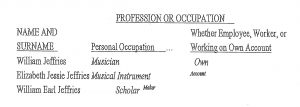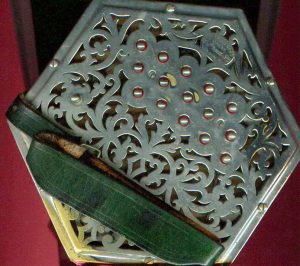Chris Algar, Stephen Chambers, Robert Gaskins,
David Lee, Randall C. Merris, and Wes Williams
This Charles Jeffries never knew a thing, never been taught anything—
most extraordinary, as he turned out an instrument that no other
maker could equal. He used the hardest steel there was, very solid.—
Tommy Williams Interview, Part 2,
Concertina Newsletter, 5 (May 1972), 7.
Appendix 1: Stamping, Etching, and Handwriting in Jeffries Concertinas
Appendix 2: Handwritten Key Diagrams and Chord Charts from Jeffries Tutors
Introduction1
This article is the companion to our biographical piece, “Charles Jeffries: The Man and His Family.” This second article focuses on the manufacturing and sales activities of Charles Jeffries (born Jacob Charles Jeffries, 1841-1906) and his sons—Charles jnr (1862-1953), William (1866-1954), George Frederick (1879-1965), and Thomas (1883-1966)—and the Anglo, English, and duet concertinas that they produced. As in our earlier article, we use “Charles jnr” to distinguish him from his father, while recognizing that the son may never have used “junior.”
As far as we know, Charles Jeffries had no technical training and was never employed by any of the previously established concertina makers;2 yet he somehow managed to produce concertinas that are widely regarded as among the best ever made. Almost nothing is known about his manufacturing and sales activities, at least as compared with what is known about the firms headed by Charles and William Wheatstone, Louis Lachenal, George Jones, and John Crabb. It seems that no manufacturing or sales records have survived from the firm of “C. Jeffries, Maker” or its successors. We have not found even one pricelist, brochure, or advertisement issued by Jeffries, and only occasional references to second-hand instruments in the advertisements and pricelists of major concertina retailers. John Hill Maccann’s The Concertinist’s Guide, a virtual “Who’s Who” of the late-Victorian concertina industry, contains no advertisement for C. Jeffries but, among the concertina makers, lists “Chas. Jefferys, Parade Street, Paddington, W.”—a doubly misspelled reference to Charles Jeffries, Praed Street.3 The later versions of Jeffries’ firm names have been found only in London post office and trade directories. Today, the instruments made by Charles Jeffries command some of the greatest interest (and highest prices) of any vintage concertinas.
The firm of Charles Jeffries produced all systems of instruments, although few examples of any types other than Anglos and the Jeffries-system duets are known, despite the existence of receipts with the heading of “English and Anglo German Concertina Manufacturers.” We can only bemoan the fact that Jeffries concertinas do not contain identifiable sequences of serial numbers such as those found on Crabb, Jones, Lachenal, and Wheatstone concertinas. Serial numbers would be most valuable for approximating the date of manufacture of the individual instruments and for estimating the total production of Jeffries concertinas. Numbers abound inside the Jeffries concertinas. However, these consist of one, two, or three digits that are either handwritten (pencil or ink) or stamped on the reed pan, underside of the action board, or upper inside edge of the bellows or that are etched into the underside of the metal fretwork (see Appendix 1). We have been unable to determine if a particular number is a model number, batch number for a production run, or a number that was the handiwork of an owner or repairer of the instrument.
The only way to obtain an approximate date for a Jeffries instrument is from its features; there are five periods of Jeffries-family-made instruments, dating approximately from 1870 to 1930, although there are overlaps between these periods. In the absence of any business records, broad characteristics of Jeffries production are thought to be as follows:
- The Jeffries firms were family operated. The production and sales staffs are thought to have consisted of Jeffries family members4 and other employees who assisted with concertina building, reed tuning, or more menial tasks. We have no specific documentation about in-shop employees or “outside workers”— those who tuned reeds or performed other tasks from their own homes or shops. We have identified only two craftsmen—Robert Carr5 and C. Streamer6—who were from outside the family but who appeared to have been associated with the Jeffries shop, as well as building concertinas on their own accounts.7 A Robert Carr concertina appears in Fig. 1.
- Some production of Jeffries concertinas is attributed to the firms of J. Crabb and George Jones, who apparently supplied concertina bodies, other components, and full instruments to C. Jeffries, Maker, at least in the early days.
- The Jeffries firms, like modern concertina builders, relied on concertina repairs to supplement the revenue from manufacture and sale of new instruments. In the 1901 census, Charles Jeffries’ second and third sons, William and George, are described as repairers. Such repair work consumed considerable time that otherwise could have been devoted to instrument building.
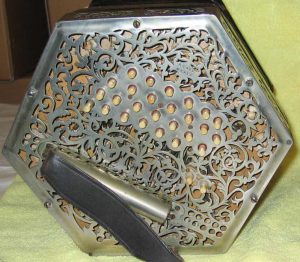
PERIOD 1: “C. Jeffries, Maker,” No. 1 White Lion Passage, c.1868-c.1878
(a) Documentation
Charles Jeffries began his working life as a brushmaker, but somehow his skills soon led him to the concertina as a trade, first, apparently, as an aspiring concertina player, then as a repairer, and finally as a maker. In the 1861 census, Charles gave his profession as “musician.” The following year, he was back to brushes, being listed as “brushmaker journeyman” in 1862 on the birth certificate of his son, Charles Jeffries jnr, and again on the 1864 birth certificate of his first daughter, Eliza Ann. On the 1866 birth certificate of son William, his occupation is given as “musical instrument maker,” but the “maker” is struck out and corrected to “mender”. On the 1869 birth certificate of daughter Mary Ann, his occupation is “musical instrument maker,” thus indicating that Charles Jeffries went into the concertina trade in earnest in the late 1860s. (All of these certificates can be seen in our companion article, “Charles Jeffries: The Man and His Family.”)
Charles Jeffries, his wife Mary Ann, his sons Charles and William, and his daughters Eliza Ann and Mary Ann moved a short distance from No. 70 Devonshire Street, Marylebone, to No. 1 White Lion Passage, Edgware Road, Paddington. The timing of the Jeffries family’s move to White Lion Passage appears to have been in 1870, as reflected in birth and census records; whereas daughter Mary Ann was born in 1869 at Devonshire Street, the Jeffries family was recorded at White Lion Passage in the 1871 British census (2 April).
White Lion Passage (between Harrow Road and Edgware Road) in Marylebone —the earliest address on Jeffries instruments—possibly was a site from which Charles Jeffries made brushes before he gravitated to concertinas. The products of the trade encompassed everything from brushes for floor sweeping to elegant hair brushes and small fine handbrushes for bench work. The brushes themselves could have brought him in contact with the Wheatstone, Lachenal, or Jones workshop. But this is pure conjecture, since we have been unable to document that Charles Jeffries (possibly joined by his father) had his own “pan shop,” the name by which a brushmaker’s shop was known.
As the address suggests, White Lion Passage was a small alleyway and was situated on the south side of the “Met” music hall. The White Lion had been a noted venue for musical entertainments since the early 1800s, but in 1864 the newly built (1862) “Metropolitan Theatre of the Varieties” reopened under new management with the White Lion Passage being incorporated. The Jeffries location provided an ideal “on-site” location for repair of instruments, as well as a sales outlet.8 During their period at White Lion Passage, the family had expanded to seven with the addition of daughter Caroline (born 1876).
In moving from brushes to concertinas, Charles Jeffries may have been following a labor of love, but also would have been on the trail of greater prosperity. The occupation of musical instrument manufacturer fell within the second-highest-paid occupation group in Robert Dudley Baxter’s “The Hierarchy of Labour 1867: Average Man’s Weekly Wage,” which appeared in The National Income (1868). The weekly wage of 28-30 shillings for musical instrument makers (who numbered about 2,200 at the time) can be compared with the 22 shilling-wage of a railway worker and the 15-20 shilling wage of a policeman. In addition, the mechanization that was creeping into brushmaking may have encouraged Charles Jeffries to leave the profession of his father behind.
A wood-fret 26-key9 concertina in the Horniman Museum Collection bears handwritten inscriptions showing “Made by C Jeffries Father 1874” on the reed pan and “Made by C Jeffries 1874” on the underside of the action board (see Fig. 2), which seems to represent one of the first instances of son Charles jnr’s involvement in his father’s business at White Lion Passage. Making a complete action may have been beyond the capabilities of someone of age 13, implying that “Made” may indicate assembly rather than fabrication by Charles jnr.
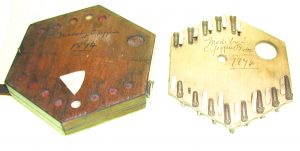
(b) The instruments
The existing Jeffries instruments that bear the White Lion Passage address range from simple 20-key or 26-key wood-fret Anglos (see Fig. 3 and Fig. 4) to sophisticated metal-fret Anglo models.
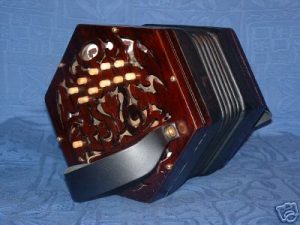
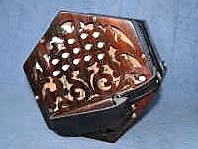
Although the comments of Crabb family members10 and Tommy Williams point to Crabb as the maker of early Jeffries concertinas, a few early Jeffries instruments have many characteristics of early George Jones concertinas. The Horniman Museum Collection includes a sophisticated metal-end Anglo concertina engraved with the White Lion Passage address and displaying features in common with Jones instruments (see Fig. 5). Jones supposedly was experimenting with progressive designs for Anglo concertinas at the time. Other concertinas bearing Jeffries’s White Lion Passage address exhibit different characteristics, distinctly in the same style as Crabb models.Fig. 4. Jeffries 26-key concertina, White Lion Passage
There is no evidence that Charles Jeffries was tutored in any way by Jones, and the occupations declared on official documents suggest the opposite. In his “Recollections,” Jones describes how his first major order for Anglos came from Scates in Dublin. Many Jones instruments have appeared with the labels of other “makers”—for instance, the label of Joseph Wallis of Euston Road, whose Jones-made instruments sometimes have the initials “J W” cut into the fretwork. It would appear that Jones supplied Jeffries with basic instruments or components, while Jeffries applied various levels of customization, depending on the sophistication of the instrument.
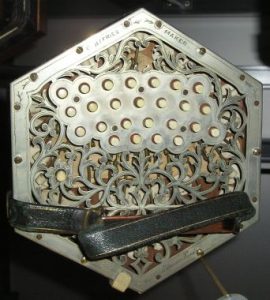
Many early Jeffries instruments were unadorned wood-fret Anglo concertinas, sometimes signed “Charles Jeffries, his own make” in ink on the inside. Other instruments have “C. Jeffries” and “Maker” stamped into the wood ends. However, fancier metal-fret instruments also carried the C. Jeffries name, even in the early days. The Horniman Museum Collection contains two Anglo concertinas that, in addition to the 50-key model in Fig. 5, are engraved with “C. Jeffries, Maker, White Lions Passage, Edgware Road.” One is a 43-key Anglo with decorative fretwork, and the other is a 49-key Anglo with engraved fretwork, gilt bellows, and gilt hand straps.
Our conjecture is that the period from the late 1860s on was one of experimentation in which Charles Jeffries was making, at best, maybe 60 percent of an instrument, with the rest (reeds, springs, buttons, etc.) being outsourced. These would have included the “Charles Jeffries, his own make” instruments, mainly of the wood-fret variety. As other Anglo concertina makers experimented with metal ends, Charles applied himself to acquiring the requisite metalworking skills. The late 1870s and 1880s, which covered much of the 102 Praed Street era (Period 2), may have been the heyday of the “Crabb hybrids.” It may have been as late as the early 1890s—the commencement of the 23 Praed Street era (Period 3)—when he started to make 100-percent-Jeffries concertinas. These would have been mainly those with “C. Jeffries, Maker” stamped between the button rows and on the endframe
PERIOD 2: “C. Jeffries, Maker,” 102 Praed Street, c.1878-c.1891
(a) Documentation
The Jeffries family moved a short distance to 102 Praed Street circa 1878. The year of the move can be approximated from the birth records for Caroline Jeffries (1876 at White Lion Passage) and George Jeffries (1879 at 102 Praed Street).
In the 1881 census, Charles Jeffries and Charles Jeffries jnr are listed as “Concertina Repairer” at 102 Praed Street. The location at 102 Praed Street proved too good to last. Toward the end of the 1880s, St. Mary’s Hospital wanted to expand onto Praed Street, and 102 Praed Street backed onto the hospital property. By 1890, St. Mary’s Hospital had acquired the freehold land on which 102 Praed Street and other properties were located.11 Photographs of this area taken shortly after the redevelopment of St. Mary’s show that the adjacent buildings were single-story shop fronts, with family accommodation at the rear. Thus, the Jeffries’s move to 23 Praed Street occurred in about 1893.
Census data show that, by 1891, Charles and Mary Ann had relocated their home to 12 Aldershot Road, Kilburn, with the two youngest brothers (George and Thomas, then age 11 and age 7, respectively) and their sisters included in the household. Charles jnr (shown in the 1891 census as “concertina maker,” age 28) and William (“musical instrument maker,” age 24) were both married and were living at 16 Aldershot Road. In between, at No. 14, lived the parents of Charles jnr’s wife, Eliza.
(b) The instruments
The metal-fret instruments from Period 2 exhibit strong similarities to those made by Crabb. To what extent did John Crabb (or later Harry Crabb) make components or entire concertinas for C. Jeffries? Documentary evidence eludes us, but circumstantial evidence and testimony of the Crabb descendants leads us to believe that John Crabb supplied concertinas at least in the early Jeffries years.12 And for this, we have found no evidence to the contrary. In an unpublished interview from the 1970s, Harry Crabb said that John Crabb, his grandfather, had built the early Jeffries concertinas, but that Jeffries had some other supplier for the reeds. Tommy Williams made the same assertion, probably having acquired his information from Henry Crabb [senior] or son Harry Crabb rather than from Harry’s grandfather, John Crabb, who died (age 77) in 1908 when Tommy Williams was about 13 years of age. Neville Crabb at one time indicated to Andrew Norman (A. C. Norman & Co, Concertina Maker and Restorer, E. Sussex, England) that all Jeffries instruments with a 4-digit number handwritten in pencil and “C. Jeffries, Maker” stamped between the button rows were made by Crabb. We do not, however, have an example of an instrument with handwritten 4-digit number. Andrew Norman has pointed out that mahogany soundboards were another shared feature of many early Jeffries and Crabb instruments. Jeffries and Crabb concertinas share other design features: riveted actions, horizontal (rather than radial) layout of the reed chambers, and highly recognizable patterns of metal fretwork that H. Crabb & Son continued to use well beyond the 1920s. More intricate similarities also have been observed.13
The saga of “Ball Beavon” concertinas—sometimes taken to be counterfeit Jeffries instruments—is illustrative of the similarity of Jeffries and Crabb concertinas. The firm of Ball, Beavon & Co.—listed at 31 Aldermanbury EC, as of 1888, and at 5 Skinner Street, Bishopsgate, as of 1902—was a wholesaler of several types of musical instruments (banjos, flutes, concertinas, etc.) labeled “Ball Beavon” but manufactured by other firms.14 The similarities of the 30-key Ball Beavon and C. Jeffries concertinas include the metal fretwork pattern and the horizontal layout of the reed-chambers, as well as the bone buttons, gold tooling, and bellows papers. “BALL BEAVON” and “C. JEFFRIES, MAKER” are stamped in similar positions (but with different sizes of lettering) on the end frames of the respective instruments. Equally striking similarities between a wood-fret Ball Beavon instrument and wood-fret Crabb and Jeffries concertinas (usually pitched in C/G or B/F#) have been noted by Andrew Norman.
Most, if not all, of the Ball Beavon concertinas with Jeffries/Crabb styling were made in the Crabb shop. Though similar in outward appearance to both Crabb and Jeffries models, the Ball Beavon concertinas usually had Crabb-type serial numbers (8000 series) inside. More convincingly, Harry Crabb addressed the issue in two correspondences (transcripts below) with a customer inquiring about the origin of his Ball Beavon concertina:
H. CRABB & SON
CONCERTINA
MAKERS
ACCORDION REPAIRS
158 LIVERPOOL RD. M.1
8/3/65
Dear Sir,
If you send us the Lachenal concertina we will find out what needs doing to it and give you an estimate of cost.
Regarding the other one, it is probably one of our make as we (at least my Father and grandfather) made virtually all of Ball Beavon concertinas for them. This firm went out of Business in 1911 so it was made before then; if it has got a serial number inside I could probably date it nearer for you. It seems like our make as Ball Beavon always ordered them pitched in B or F# from us.
Yours Faithfully
H J Crabb
H. CRABB & SON
CONCERTINA
MAKERS
ACCORDION REPAIRS
158 LIVERPOOL RD. M.1
London 2/10/65
Dear Sir,
Re your Concertina 8431: it was made in 1892.
We are afraid this is the only information we can give as no other details are listed in our book.
Hoping this proves satisfactory.
Yours faithfully
H Crabb
Geoffrey Crabb has indicated that he does not have manufacture or sales records for the Ball Beavon concertinas, but he has provided a Crabb sales record for Ball Beavon cases (see Fig. 6).
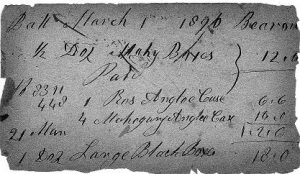
Some Jeffries and Crabb concertinas, though almost identical in appearance, have intriguingly different sound qualities, usually attributed to differences in the reeds. The Jeffries family recognized the proprietary value of Jeffries reeds, supposedly refusing to sell them to other makers or repairers who wished to retrofit concertinas by other makers. Tommy Williams recalled his own experience: “Talking about this here brass reeded instrument, I thought it’d sound alright with a set of steel reeds in it, so I went to Charlie Jeffries to get some of his steel, but he wouldn’t part with it, kept it to themselves.”15 Tommy indicated that he persisted through an intermediary, but to no avail: “…when I had my first brass reed duet, a man offered to make a set of steel reeds. He said, ‘I’ll ask Charlie Jeffries to let me have some of the steel they use.’ Well, he showed me what Jeffries gave him—a solid block of steel! Course, he was having him on.”16 Geoffrey Crabb has indicated that his ancestors supplied Charles Jeffries with reeds. According to Geoffrey, the key element was the re-tempering of the reeds on a “hotplate” in the Jeffries shop.17
Although some Jeffries concertinas are stamped internally with the address, most feature “C Jeffries Maker”‘ stamped into the fretwork between the rows of buttons (see Fig. 7), with some instruments also having “C. Jeffries, Maker” stamped into the side wood of the ends (see Fig. 8). The use of the same end stamping method on some wood-fret instruments suggests that they were also part of the Jeffries product line during the same period.
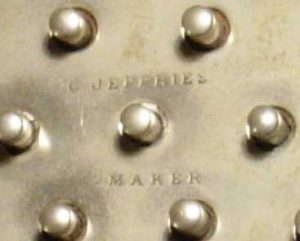
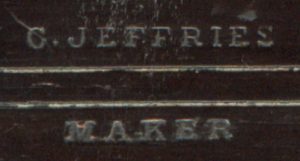
The mainstays of the C. Jeffries product line were the 26-key (see Fig 9), 30-key, 38-key, and 44-key models. A drone key to be operated by the left thumb was added to the basic design on some instruments, resulting in 31-key (see Fig. 10), 39-key (see Fig. 11), and 45-key instruments (see Fig. 12). Anglo models with as many as 50 keys also were included in the product line. Wooden hand rests and either bone or metal buttons were standard for 26-key, 30-key, and 38-key instruments; metal hand rests and metal buttons appear to have been standard for instruments with 44 or more keys (although at least one 44/45-key Jeffries instrument with bone buttons has come through Andrew Norman’s shop). Some 44/45-key instruments have silver-plated ends (particularly, some in Bb/F tuning), whereas others (e.g., in C/G) have nickel ends. Standard features included six-fold black (or greenish black) leather bellows with the distinctive Jeffries design of gold-on-white bellows papers (see Fig. 13). Seven-fold bellows and other patterns for the bellows papers were available on demand.
“C. Jeffries, Maker” Anglo concertinas with other key configurations and design features were also available within the product line or as special-order custom models. Jeffries concertinas with 28 keys are relatively rare. Unusual Jeffries instruments in the Horniman Museum Collection include a 32-key instrument with wood fretwork and a 46-key instrument with metal sides, as well as metal fretwork. We have seen very few 20-key Jeffries concertinas. We have seen a few “small-bodied” C. Jeffries, Maker concertinas that have metal fretwork and a full complement of 30 keys, but are only 5 inches (rather than the usual 6 inches) across the ends.
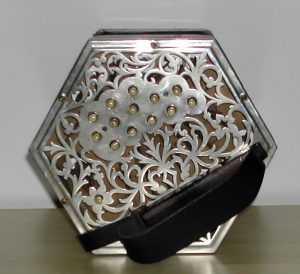
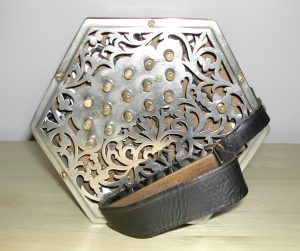
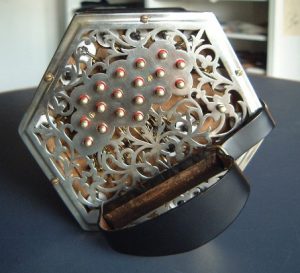
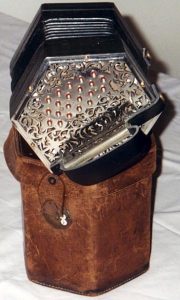
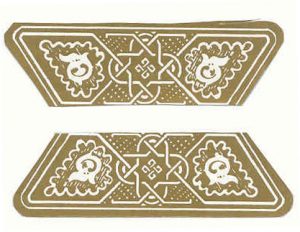
A popular tuning was that in C/G (i.e., tuned to the C-major scale in the middle row and the G- major scale in the bottom row), but other tunings such as Ab/Eb and Bb/F were also in demand. Today, we also find Jeffries concertinas tuned in G/D. Some were tuned in G/D in the Jeffries shop, but many were originally in Ab/Eb (which the Salvation Army considered a standard tuning) and were later converted to G/D by retuning/rearranging the reeds. More unusual tunings were also available, including “mean-tone” tuning (with separate notes for Eb and D# and Ab and G#) and “half-tone sharped tunings” (A# in place of A, B# in place of B, C## in place of C#, etc. (or, stated differently, they were tuned in relation to an A that was pitched higher than A=440).
The “C. Jeffries, Maker” instruments were relatively comparable with respect to high quality material and workmanship for the ends, metal fretwork, riveted actions, bellows, gold tooling, etc. All models were fitted with quality steel reeds that produced the sweet tone for which the Jeffries concertina became famous.
The reeds in Jeffries instruments are slotted into lateral layouts of reed chambers (see Fig. 14)—in contrast to the radial arrangement of reed chambers in Lachenal concertinas. Concern for durability is exemplified by the spot soldering that is found on the underside of the fretwork and is used to reinforce the metal around the end-screw holes. However, one anomaly stands out—namely, handstrap-length-adjustment thumb screws that are threaded directly into the side wood of the ends. Repeated adjustment of the strap can cause the screw hole in the side wood to become so enlarged that the thumb screw no longer holds. A more durable design is a machine-thread thumb screw that fits into a metal nut that has been countersunk in the side wood. The only such screw-and-nut fittings that we have seen on Jeffries concertinas have been those installed at the repair stage.
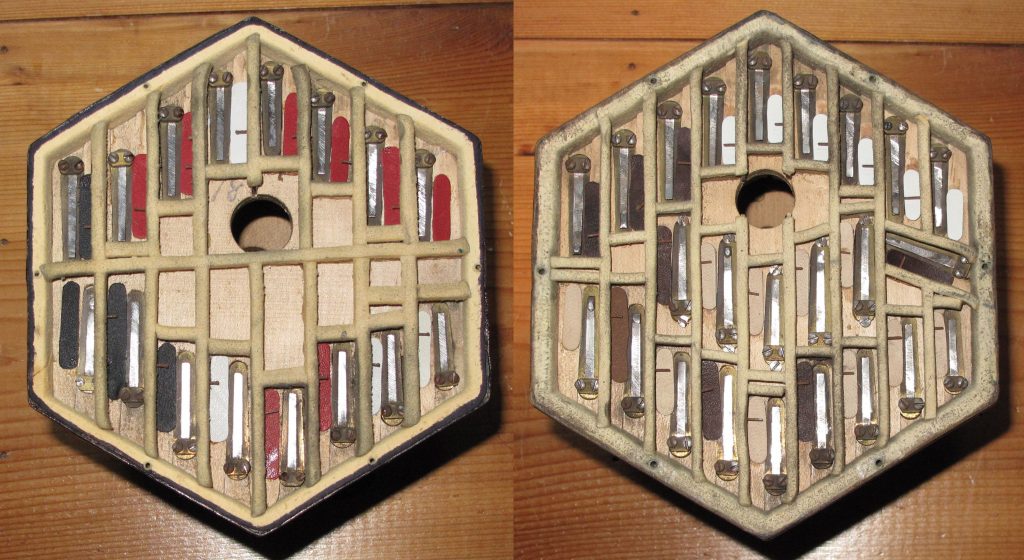
The metal fretwork on most Jeffries concertinas extends all the way to the sides of the ends, but exceptions exist. We know of two 38-key “C. Jeffries, Maker” Anglo concertinas in which the metal fretwork is inset into the wood ends. This recessing of the fretwork creates a wood border, approximately 3/8s of an inch wide, around the perimeter of the end (see Fig. 15).
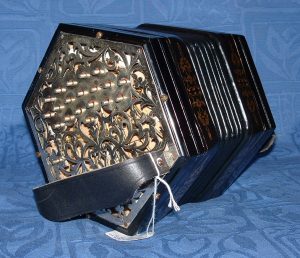
Jeffries concertinas with the Jeffries style fretwork, but without the beveled perimeter of the metal fretwork, are also rare. We have seen only a couple of these “totally flat end” instruments (see Fig. 16). One is a 28-key C/G Anglo concertina with another rare trait— an ink stamp on the reed pan that shows C. Jeffries, English Concertina Maker, 102 Praed St., Paddington, attesting to its fairly early origin (see Fig. 17 and Fig. 18). The instrument has no external stampings or inscriptions of “C. Jeffries, Maker” on the fretwork or endframe.
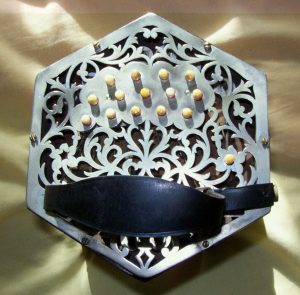
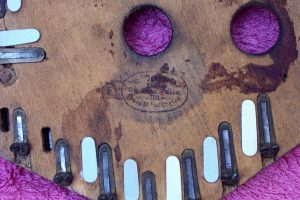
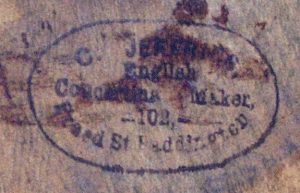
An English-system Jeffries concertina is stamped with “C. JEFFRIES” and “MAKER” directly above the middle two rows of buttons (see Fig. 19 and Fig. 20). The Horniman Museum Collection also contains an English concertina by “C. Jeffries, Maker.”
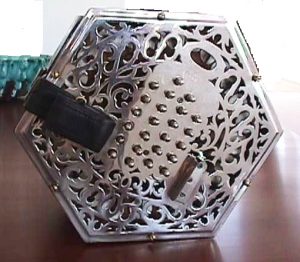
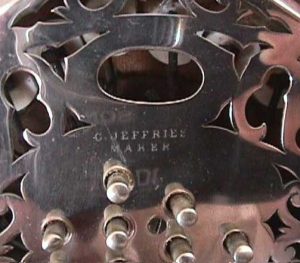
PERIOD 3: “C. Jeffries, 23 Praed St,” c. 1893-1908
(a) Documentation
Figure 21 shows a Jeffries concertina inscribed with the 23 Praed Street address.
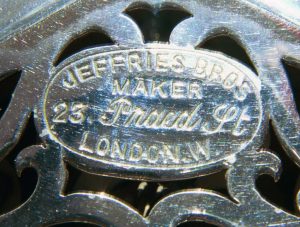
It is difficult to date the beginning of Period 3 accurately. The address for the Jeffries business in the Post Office Directory London changes from 102 Praed Street in 1892 to 23 Praed Street in 1894, and the death certificate of William Jeffries’ first wife, Emma Eliza Jeffries, in June 1893 gives the 23 Praed Street address of Mary Ann Jeffries (the daughter of Charles and Mary Ann, who married on Christmas Day of 1894 while residing at 23 Praed Street). Kelly’s Directory for 1890 lists Charles [jnr] and William Jeffries as residing on Aldershot Road. With these facts in mind, we suggest that the business started at 23 Praed Street circa 1893
No. 23 Praed Street was located on the south side of the street, between the adjoining Edgware Road and Sale Street. Today, this area has been totally redeveloped, and only the “Great Western” public house on the corner of Sale Street has survived. Maps of the area show a terrace of houses, with the Baptist Chapel (by 1914, a cinema) located near its center. In 1882, No. 23 seems to have been an office of the Paddington Times. Old photographs of buildings in the area indicate that the houses were probably three storeys, like the “Great Western,” often with double-fronted shops at ground level and living quarters sometimes above.
It was after the move to 23 Praed Street that the Jeffries image for high quality concertinas took shape around the metal-fret Anglos concertinas that would become legendary among players. Charles Jeffries’ sons each engaged in concertina making and/or repair. In 1893, William Jeffries occupation was “Concertina Maker Journeyman,” as recorded on the death certificate of his first wife, Emma Eliza. In the 1901 census, Charles jnr was listed as a “Musical Instrument Makers Assistant,” and William as a “Metal Music Reed Voicer & Repairer.” George Jeffries probably joined the business in the mid-1890s, his occupation given “Musical Instrument Repairer” in the 1901 census, which fails to list an occupation for Thomas, age 17 and presumably still a scholar. Thomas, though, would eventually be the last of the Jeffries to uphold the family tradition, selling concertinas under the Jeffries Bros. name into the early 1960s.
By 1901, Charles Jeffries (listed in the census as “Musical Instrument Dealer”) and Mary Ann Jeffries, along with George and Thomas, had moved to nearby Willesden, as had William and his family. Charles jnr and his family had moved into 12 Aldershot Road, and the 23 Praed Street premises had become the residence of the families of Charles Jeffries’ two surviving daughters, by then married. Daughter Mary Ann had died in childbirth in 1895.
The headings on two sales receipts from 1899 show “Bought of Charles Jeffries, English & Anglo German Concertina Manufacturer, 23, Praed Street, Paddington, W.”18 (see Fig. 22 and Fig. 23). The appearance of “English” before “Anglo” in the heading distracts from the fact that most “C. Jeffries, Maker” concertinas were Anglo instruments. We have seen only a few “C. Jeffries, Maker” English concertinas. The heading does not mention the duet concertina, but it is known that a few “C. Jeffries, Maker” duet concertinas were made. The blank sales receipts, though printed after the move to 23 Praed Street (circa 1893), possibly pre-dated the appearance of Jeffries duets. Period 3 ended with the death of Charles Jeffries in 1906 or soon thereafter.
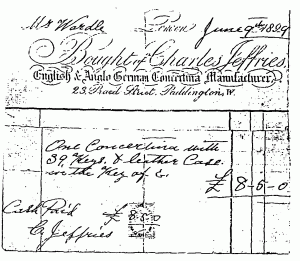
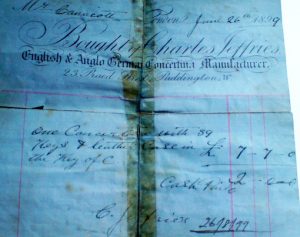
(b) The instruments
Given the lack of Jeffries serial numbers and records, it is impossible to approximate the specific year of manufacture of a Jeffries instrument. Our best estimates pertain to the production periods, rather than exact years, in which individual concertinas were built. We have determined these periods on the basis of the exterior stampings: “C. Jeffries, Maker” between the keys and/or in the wood end (Period 2), followed by “C. JEFFRIES, MAKER, 23 Praed St. LONDON, W” engraved in the elliptical area (oval) at the top of the right-side fretwork (Period 3), and later by “JEFFRIES BROS, 23 Praed St., LONDON, W” in the oval (Period 4). At issue is the timing of the introduction of the “C. JEFFRIES, MAKER, 23 Praed St. LONDON, W” engraving in the oval. It may have appeared shortly after the Jeffries shop was relocated from 102 Praed Street to 23 Praed Street, c. 1893 or some time later. On the other hand, information from the Crabb family suggests that the introduction of the name/address oval may date from as late as circa 1895, when Charles Jeffries started making complete instruments, without Crabb components. A new fretwork pattern was introduced along with the inscribed oval on the right side. On some instruments, “C. JEFFRIES” and “MAKER” still were stamped between the button rows, but on the left-side end.
A still later period has also been suggested for the introduction of the “C. JEFFRIES, MAKER, 23 Praed St. LONDON, W” oval: even as late as after Charles Jeffries’s death in 1906. The relative newness of the overall physical appearance of many instruments with the distinctive oval has also been noted in suggesting that all were built after the1890s. However, the quantity of such instruments appears too large to suggest that they were produced in such a short time span prior to the introduction of the “JEFFRIES BROS, 23 Praed St.” oval (Period 4).
In addition to their distinctive bellows papers, Jeffries concertinas are characterized by gold tooling in the leather covering the bellows frame that attaches to the end assembly. Though similar, the gold tooling patterns differ across instruments. Examples of the gold tooling on various Jeffries concertinas are shown in Fig. 24. We have been unable to ascertain if the use of different gold tooling dies varied by Jeffries manufacturing period, by model of Jeffries concertina, or simply at the discretion of the worker doing the tooling. In particular, we have been unable to use the gold tooling information in estimating the manufacturing periods for Jeffries concertinas.
Fig. 24. A selection of gold bellows-frame tooling on Jeffries concertinas:





The fretwork and stamping on some instruments have a different design, with (1) a more intricate pattern in the metal fretwork and (2) “C. JEFFRIES, MAKER” only (i.e., without the Praed Street address) stamped in the oval at the top of the right-side fretwork. This fretwork design and oval stamping may have been introduced relatively early, specifically for instruments with relatively large numbers of keys. A distinguishing feature of many of these instruments is presence of metal hand rails. Those from the earlier period also have the “C. Jeffries, Maker” stamping between the button rows (left side) and on the endframe, as well as the “C. JEFFRIES, MAKER” in the oval.
Two such instruments are the 45-key Anglo concertina shown on top of its leather case in Fig. 12, and the 50-key Jeffries-system duet concertina (which was converted to an Anglo concertina in Bb/F) shown in Fig. 25. This fretwork pattern and similar stamping in the oval appear also on some Crabb concertinas.
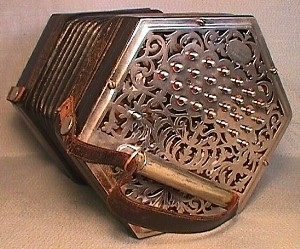
The invention of the Jeffries-system duet concertina may have emerged before 1900, during the period when other duet systems were being developed in response to the introduction of the MacCann duet concertina (John Hill Maccann, “Improvements in Concertinas,” Patent No. 4752, March 12, 1884) and may have preceded the introduction of the Crane duet concertina (John Butterworth; Patent No. 21,730, September 28, 1896). However, it is possible that the Jeffries-system duet was not introduced until the early 1900s.19
Many of the duet concertinas were made later, under the auspices of Jeffries Bros. or Charles Jeffries [jnr], 12 Aldershot Rd., but some (both Jeffries-system and other duets) were made in the “C. Jeffries, Maker, 23 Praed St.” period. Some of these duets have very pronounced raised metal ends, which were not typical of Jeffries Anglos during the same period. The 50-key raised-end duet concertina shown in Fig. 26 has the oval inscribed with “C. Jeffries, Maker, 23 Praed St.” It has broad expanses of plain metal, bearing no resemblance to other Jeffries patterns. The fretwork is of a finer cut, a characteristic of earlier instruments.
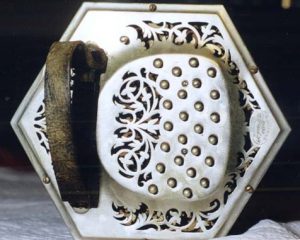
A 57-key raised-end Maccann duet concertina (see Fig. 27 and Fig. 28) has “C. JEFFRIES, MAKER 23 Praed St. LONDON W.” in the right-side oval—the same as “C. Jeffries, Maker” Anglo concertinas. The instrument has metal ends that are finely cut and are raised to a pronounced degree. Such extrusion of the metal, though without the fretwork fineness, was prevalent for both Anglo and duet instruments by “Jeffries Bros.” and “C. Jeffries, Aldershot Road,” but was less common for all types of “C. Jeffries, Maker” concertinas. The instrument probably dates from between 1898 (the year in which the patent that had been granted to John Hill Maccann and assigned to Lachenal & Co. in 1884 expired) and 1908. A 46-key raised-end Maccann duet concertina by “C. Jeffries, Maker” is shown in Fig. 29.
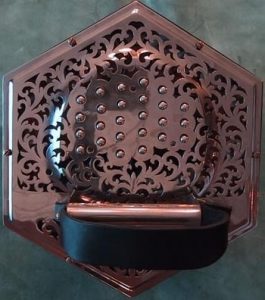
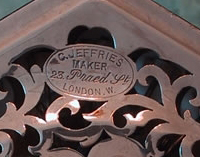
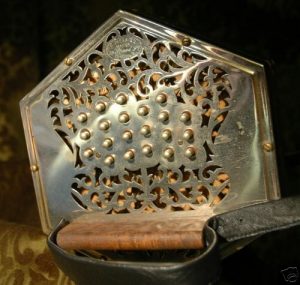
Jeffries miniature concertinas are extremely rare. In fact, we have seen only one instrument that almost surely is a Jeffries model (though it is not stamped or labeled with the Jeffries name).20 It is a 10-key miniature Anglo concertina that is owned and expertly played by the well-known Anglo concertinist Noel Hill. Hill’s miniature is housed in a wee version of the hexagonal leather cases usually associated with Jeffries concertinas (see Fig. 30). We have never seen an English- or duet-system miniature concertina with the appearance of Jeffries manufacture.
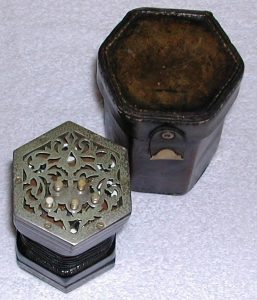
PERIOD 4: “Jeffries Bros, Maker,” 23 Praed St, c.1908-c.1923
(a) Documentation
Figure 31 shows a new name for the firm: “Jeffries Bros.”
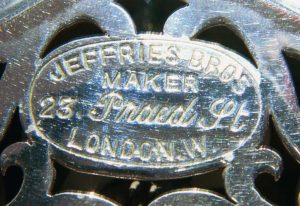
The transition from “C. Jeffries, Maker” to “Jeffries Bros.” took place sometime between 1908 and 1911, possibly when Mary Ann Jeffries transferred the business to her sons. The Post Office London, Commercial and Professional Directory for 1910 still showed “Jeffries, Charles, concertina maker, 23 Praed Street W.,” but in practical terms the business had been Jeffries Bros. since shortly after Charles Jeffries’ death in 1906. Subsequent editions of the Post Office London, Commercial and Professional Directory showed “Jeffries Bros, concertina makers, 23 Praed Street W.”
Dating the introduction of “JEFFRIES BROS, 23 Praed St.” in the right-side oval of their concertinas is of particular interest, but, as with so much else about that company, we cannot do so conclusively. We suggest that the “Jeffries Bros” inscription did not appear until around 1909/1910, based on the following circumstantial evidence:
- 1907: A 44-key Jeffries Anglo concertina is shown on the cover of a 1986 issue of Concertina Magazine, and is described as follows: “The instrument has a maker’s label of ‘C. JEFFRIES, MAKER, 23 Praed St. LONDON, W’ on the right-hand side, there being no label on the left-hand side. This concertina, like other Jeffries Concertinas, does not bear any number for identification, nor for allowing a date to be put on the instrument. However, in this case it is known that the instrument was built in 1907, since the first owner has inscribed this on the inside woodwork, along with his address.”
- 1909: In that year, William Kimber—legendary Morris dance concertinist—was presented with a Jeffries concertina purchased by his admiring fans. From the photo on the cover of his LP and CD (see Fig. 32), it can be discerned that the right-side oval of his concertina shows “C. JEFFRIES, MAKER, 23 Praed St. LONDON, W.”21
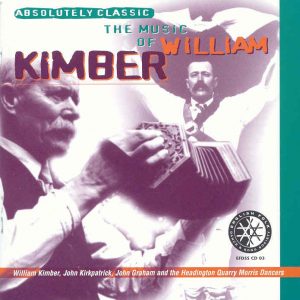
The new inscription in the oval may have been one of the Jeffries brothers’ first independent decisions, made shortly after the death of Charles Jeffries in October 1906. It appears that Charles Jeffries did not assign ownership rights or managerial titles to his sons, and he never included “& Sons” in the company name (even after his retirement or semi-retirement before the 1901 census). In the record of William’s first marriage, to Emma Eliza Cowens in 1888, his occupation was shown as “Concertina Maker.” In the 1891 census, the occupations of Charles jnr and William were shown as “Concertina Maker” and “Musical Instrument Maker,” respectively; and in the Kelly Street Directory for 1894, each was listed as a “Musical Instrument Maker.” However, in the 1901 census, the four sons are listed as Maker’s Assistant,” “Reed Voicer” and/or “Repairer,” rather than as “Maker.” The next reference to a son as a maker is in the probate document for the estate of Charles Jeffries [senior], where Charles jnr is shown as “musical instrument manufacturer.” After laboring under their father, the sons may have been eager to make some changes, including the fretwork modifications and the new inscription on the instruments. The Jeffries sons may have availed themselves of the opportunity to do some other re-tooling as well. The gold tooling on C. Jeffries bellows appears to have involved two operations of a single pattern stamp. From various photos, it seems that earlier bellows were stamped to ensure that the patterns joined in the center. Later bellows tooling has a gap at the center. The latter type of gold tooling ends in an open ellipse at the corners, whereas the earlier type appears to have an additional small filled ellipse after the open ellipse (see Fig. 24).
In later years, George Jeffries often related to his family how the years prior to the First World War were the “golden” period of his life, with all his brothers involved in the business. However, George’s recollections seem to have overstated his and Thomas’ involvement, given that they were also pursuing other interests. In the 1911 British Census, Charles Jeffries jnr is shown to have been engaged in the Jeffries Bros operations on a full-time basis. The census shows Charles Jeffries [jnr], age 48, residing with wife Eliza May and their eight children at 12 Aldershot Road, Kilburn. His occupation is listed as “Musical Instrument Maker,” and his employment status is shown as “operating partner.”
George Frederick Jeffries (listed as Frederick Jeffries in the 1911 census), age 32, was living with his wife May and a boarder at 373 Kingsland Road, South West Hackney, London. His occupation is shown as “Off License Wine and Bottled Spirit.” The 1911 census shows Thomas Jeffries, age 26, wife Victoria, and son Thomas residing at 231 High Road, Kilburn. His occupation is listed as ‘Licensed Victualler” (that is, usually an innkeeper or pub owner).22
The 1911 census entry for William Jeffries is neither immediately legible (see Fig. 33) nor entirely unequivocal with respect to occupation. William Jeffries had married Elizabeth Jesse Stewart (1870-1932) in 1894, a little over a year after the death of first wife Emma Eliza. The record shows William, wife Elizabeth Jessie, and their two sons—William Earl Jeffries (1895-1959) and Maurice Edward Jeffries (1902-1989)—residing at 38 Craven Park, Harlesden N. W., and his occupation listed as “musician.” The next two lines of the census form are somewhat confusing, as shown in the following reproduction of the placement of the relevant wording (shown in italics):
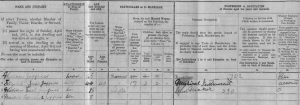
The census form appears to show that William Jeffries was a professional musician and that wife Elizabeth Jesse was the musical instrument maker in the family. However, “Musical Instrument Maker” is almost certainly a continuation and qualification of the “Musician” in the listing of William Jeffries’ occupation, necessitated by lack of space on the census form. This explanation is consistent with Jeffries descendants’ claim that Charles Jeffries jnr and William Jeffries were the mainstays of the Jeffries Bros. business during the pre-war and WWI periods.
Before finding Jeffries Bros. in the Post Office London, Commercial and Professional Directory, we had thought that the transition from “C. Jeffries, Maker” to “Jeffries Bros” had taken place around 1920. We had been misled by three sales receipts with the Charles Jeffries heading: (1) a sales receipt that William Jeffries signed on March 1, 1913, shown in Fig. 34; (2) a sales receipt that Thomas Jeffries signed on October 25, 1920, shown in Fig 35; and (3) a sales receipt that Thomas Jeffries signed on November 10, 1920, shown in Fig 36.
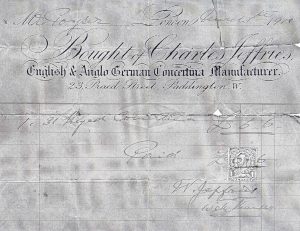
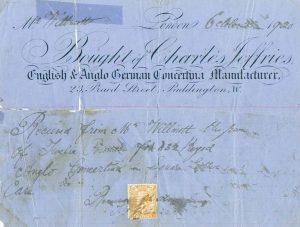
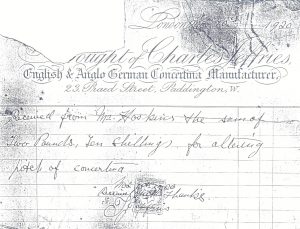
In fact, for several years, Jeffries Bros used both the old stock of Charles Jeffries sales receipts and handwritten Jeffries Bros. receipts, either interchangeably or based on the type of purchase. A Jeffries Bros. sales receipt that Charles Jeffries jnr wrote on 11 February 1914 is shown in Fig. 37, while a handwritten Jeffries Bros. receipt dated 18 June 1922 appears in Fig. 38.
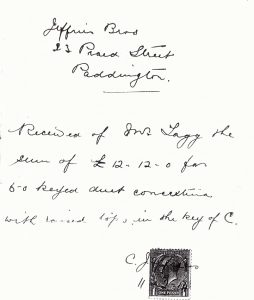
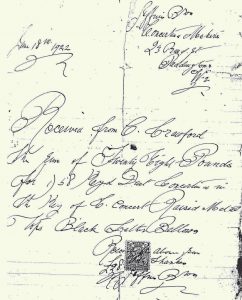
The decline in business that eventually led to the demise of Jeffries Bros. began during World War I (1914-18), when the Jeffries brothers and their sons were called to serve. Only Charles jnr was too old for conscription, though his only son was killed in France in 1917. George was injured in the war and went on disability.
We do not know the extent to which the Jeffries brothers reduced production or sales activities during the First World War. In fact, Jeffries Bros. was officially registered in 1915, when the war already was raging. On the supply side, the war would have caused difficulties in production, especially when employees were called to service and when materials were in short supply. On the demand side, it has been assumed that the concertina market was drained by the war, as many concertina players marched off to the trenches. However, the actual impact on the concertina market may have been less than often supposed. Surprisingly, during the war and its aftermath, Anglo concertina production at Wheatstone & Co., though of relatively modest proportions, was actually higher than in pre-war years. The Jeffries and Wheatstone markets may have been affected similarly.
The transition to Jeffries Bros. may have been accompanied by a transfer of ownership from Mary Ann Jeffries to her sons (possibly with some shares of the firm or other real property going to her daughters). Full or partial transfer of ownership without full compensation would help to explain the decline in Mary Ann’s fortunes after Charles Jeffries died. In 1906, Charles Jeffries’ estate was valued at £11,162 gross and £6,673 net (equivalent to about £2 million in 2002). In 1919, Mary Ann Jeffries estate was valued at £1,523 gross and £1,404 net (equivalent to about £160,000 in 2002).23 Although other factors could account for the decline in assets between 1906 and 1919, Mary Ann’s transfer of ownership of the company to her children would have been a contributing factor.
Mary Ann died in 1919, and differences among the brothers started to emerge. Although Mary Ann left everything to be equally shared among her children. various members of the family have related how Charles jnr, designated as her executor, managed to divide the estate so that the two younger brothers did not receive their full entitlement. The split-up among the brothers supposedly was far from amiable. Suzanne Charles, great-granddaughter of Charles, jnr, has said that “He [Charles jnr] apparently swindled two of his brothers out of money.”
Jeffries Bros. is believed to have ceased concertina manufacture and trading on a major scale in the early 1920s, even though the company was not dissolved at that time. Thomas Jeffries still traded under the Jeffries Bros. name into the 1960s.
The date of the company’s departure from the Praed Street premises is not clear. It may have been related to the Praed Street redevelopment that was completed during or after the war. In 1934 and 1937 directory listings, the Jeffries Bros. address is given as No. 18, Lincoln Mews, Kilburn.
The existence of printed receipts (c.1920) with the heading “C. Jeffries” and signed by Thomas have provided false clues in the past; in fact, they probably suggest that Thomas was struggling to make Jeffries Bros. survive. The Horniman Museum has a handwritten receipt from “Jeffries Bros.” from mid-1922 in Thomas’s handwriting that suggests the same.
(b) The instruments
Instruments of Period 4 often have thicker cut fretwork than those of earlier periods. A 30-key Jeffries concertina with such fretwork is shown in Fig. 39).
Jeffries Bros. specialized in metal-fret Anglo and duet concertinas. We have never seen an English-system or wood-fret Jeffries Bros. instrument. For decades, the low-budget market for English-made concertinas had been conceded to Lachenal & Co. and George Jones & Sons. After the closure of Jones & Sons in 1909, Lachenal & Co. still remained to produce the less-expensive line of English-made Anglo concertinas. Jeffries Bros, on the other hand, seems to have targeted the “high-end” market. Many of their Anglo concertinas were 38-key models in C/G or some other tuning (see Fig. 40). For some of their Anglo concertinas, Jeffries Bros. used key layouts and reed chamber arrangements that were the same or similar to those of the 44-key Jeffries-system duet. The 50-key model became a popular choice for the Jeffries-system duet concertina, though some were made with up to 72 keys. Some raised-end concertinas made by Jeffries Bros. are relatively heavy and are a little wider than the usual 6 inches across the ends. Although highly sought, these instruments are not considered to be among the best Jeffries instruments.
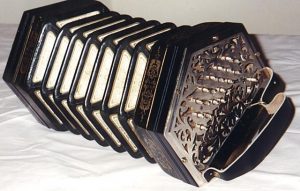
In addition to the more plentiful Jeffries-system duets, a few Jeffries Bros. Crane-system duet concertinas have surfaced. Fig. 41 and Fig. 42 offer two views of a 57-key instrument.
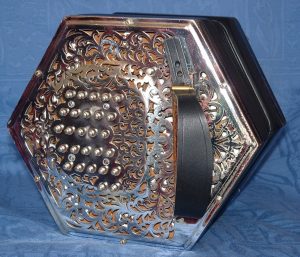
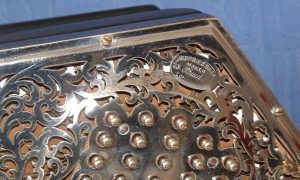
The Jeffries brothers did not publish concertina tutors, but produced a number of handwritten ones for the use of their customers and students. The tutors contained diagrams showing the layout of the keys and chord charts and occasionally included a few tunes in rudimentary tablature. We have copies of a Jeffries-system duet tutor that Thomas Jeffries penned in 1959, a MacCann duet tutor, and an Anglo concertina tutor (see Appendix 2). From an analysis of the handwriting, it appears that the tutor for the MacCann duet concertina was written by Thomas Jeffries. The Anglo concertina tutor, on the other hand, might have been written by William Jeffries. Appendix 2 offers an illustration from a handwritten Jeffries-system duet tutor in the hand of Charles jnr (Fig. A2.4).
PERIOD 5: C. Jeffries 12 Aldershot Road, Kilburn, c.1923–c.1930
(a) Documentation
Figure 43 shows an instrument that dates from the period of Aldershot Road:
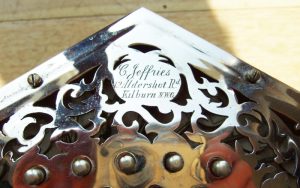
During the early 1920s, Charles Jeffries jnr established his own concertina making business at 12 Aldershot Road, Kilburn, North London, which had already been his residence for two decades. We have not been able to pinpoint the exact time when Charles jnr set up shop in his home. The London directories list 12 Aldershot Road as his residence, but not as a commercial address. Perhaps it was the death of his mother that served as the catalyst for the relocation. We have no indication that he left earlier. Of the concertinas stamped or inscribed with both a date and 12 Aldershot Road, we have not seen a single instrument with a date earlier than in the 1920s.
Some of the instruments show that, initially at least, Charles, jnr was producing instruments with care and with carefully engraved florid ovals. Later instruments are easy to recognize from the hammer- stamped block capitals, with a characteristic reversed letter ”И” (that is, a reverse “N” of sorts), as shown in Fig. 44. Charles Jeffries jnr also seems to have put this stamping on second-hand concertinas from earlier Jeffries periods. Two 39-key Anglos (one of which is at the Horniman Museum) contain internal stampings of “33” and “34”; these may be serial numbers.

Charles Jeffries jnr may have taken some of the Praed Street tools and inventory with him when he moved his work to Aldershot Road.24 Dual stampings appear on some of his concertinas—i.e., instruments stamped with “12 ALDERSHOT ROAD, KILBURN, N.W. 6,” as well as “C. Jeffries, Maker” or “Jeffries Bros.” However, the explanation simply may be that his Aldershot Road stamping was added to Jeffries instruments that he acquired in the second-hand market.
Charles jnr’s association with concertinas gave way to other pursuits, but he seems to have maintained at least a passing interest, particularly in the Jeffries-system duet concertina. According to Suzanne Charles, his great-granddaughter, he invested in real estate and attained notable wealth: “He also owned a lot of property in London. 12 Aldershot Road was occupied by my great aunt until 1975…. My father remembers his grandfather with ‘bags of money’!”
We get an inkling of Charles Jeffries jnr’s continuing involvement with the concertina—slight though it is—from a handwritten Jeffries-system duet tutor, supposedly from the 1940s. Probably the only surviving remnant of that involvement, it is an image of the key diagram from a leather-bound handwritten tutor, which shows “Charles Jeffries” and the Aldershot Road address at the top of the page (see Fig. A2.4 in Appendix 2).25
The property at 12 Aldershot Road suffered through the Blitz. Suzanne Charles has mentioned that “My Dad’s cousin, another grandchild, had them stay when their house at Aldershot Road was bombed during the war.” Rose Beatrice Counsell—the eldest of Charles Jeffries jnr’s daughters—died at 12 Aldershot Road in September 1974, and the property was sold outside the family shortly thereafter.
Although we do not know when Charles Jeffries jnr ceased to focus on making concertinas, it seems reasonable to assume it was by the early1930, as he had invested in property, and made his living from income from rentals until his death in 1953. In fact, the 1939 National Identity Register26 lists Charles Jeffries jnr as residing at 12 Aldershot Road and describes him as “Musical Instrument Manufacturer Retired.” Directory listings for 1934 and 1937 show “Jeffries Bros. 18, Lincoln Mews, Kilburn NW – English and Anglo concertina makers”, but a near contemporary street directory does not list this address.
(b) The instruments
Charles Jeffries jnr, like Jeffries Bros., seems to have specialized to some degree in 38-key Anglo and Jeffries-system duet concertinas. Of the relatively limited number of C. Jeffries, Aldershot Road instruments that we have seen, most have raised metal ends. Some have nice fretwork, whereas others have what started as standard flat Jeffries-style fretwork that was extruded into raised ends. As a result, the air button that is normally centered within a floral motif is mounted further back in the first available blank area of fretwork (see Figure 45). Fig. 46 shows a 38-key Anglo that has “C. Jeffries, Aldershot Rd” placed along the border of the fretwork. Some instruments carry a florid engraving of “C. Jeffries, 12 Aldershot Road” (see Fig. 47); others had a different engraving in the oval or were stamped with simple block lettering.
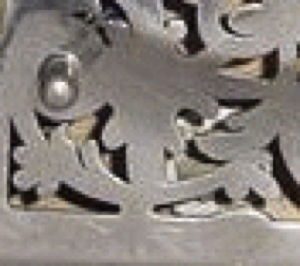
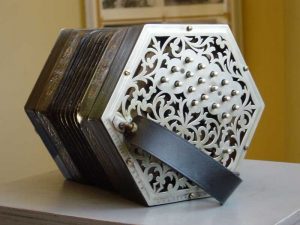
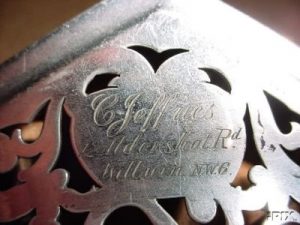
We have what appear to be original purchase dates for only two of Charles Jeffries jnr’s instruments: (1) a 45-key Anglo concertina (Ebay auction, January 2002; later advertised by an English dealer) and (2) a 45-key Anglo concertina (Ebay auction, June 2003). Each has raised metal ends, metal buttons, 7-fold bellows, and “C. Jeffries, 12 Aldershot Rd Kilburn NW6” inscribed in the right-side oval. Each instrument has a name and purchase date engraved beneath the hand rest: (1) “A.G. Littleboy, April 25, 1925” and (2) “C. T. Denyer, April 1926,” respectively. Each currently is pitched in C/G, but the “C. T. Denyer” instrument was retuned from a different Anglo key combination (possibly Bb/F) or was converted from a Jeffries duet system (handwritten inside: “tuned to C/G, A. C. Norman, 1985”). It is not known whether the C/G Anglo tuning of the “A. G. Littleboy” instrument is original.
One 38-key instrument owned by a player (anonymous) in Ireland has “Jeffries Bros, 23 Praed St., London” and “1927” inscriptions, as well as an “Aldershot Road, Kilburn stamping on the fretwork edge. A 50-key instrument has “LATE Jeffries Bros” at the top of the right side and “C. J. NEW ADDRESS, 12 ALDERSHOT, KILKBURN, N. W. 6” next to the right-side handrest (see Fig. 48). Two other Anglo concertinas—a 38-key and a 44-key—are stamped “C. JEFFRIES, MAKER” in the right-side oval and “12 ALDERSHOT ROAD, KILBURN, N.W.6” along the edge of the fretwork beneath the right-side hand rest (see Fig. 48 and Fig. 49). The oval stamping and the metal fretwork are like those on some concertinas from the “C. Jeffries, Maker” period. However, some of the stamping is less precise. Both instruments have the rough stamping of the Aldershot address along the fretwork edge, including reverse stampings of the “И” in “KILBURИ“ and in “И.W. 6.”27 (How a stamping die for “N” could have been reversed is unexplained, since if merely held upside down, an “N” looks exactly the same. Possibly the die was from another set intended for stamping from the reverse of materials to produce a raised letter on the front.) The 38-key instrument also has overstamping to correct for mislettering of “ALDERSHOT.” Our guess is that such instruments may date from just prior to the closure of Charles Jeffries jnr’s shop, when he was making less-than-pristine instruments from a stock of partly finished components.
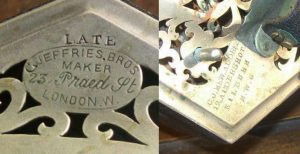

A few instruments inscribed with “W. Jeffries” have surfaced (see Fig. 50). An interesting 4-row Anglo concertina is shown in Figures 51 and 52. Other instruments tend to be indistinguishable from Jeffries Bros instruments, except for the W. Jeffries inscriptions. The William Jeffries concertinas probably date from around 1920.
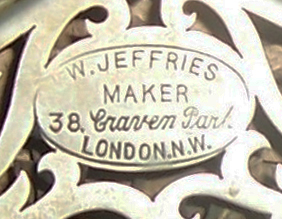
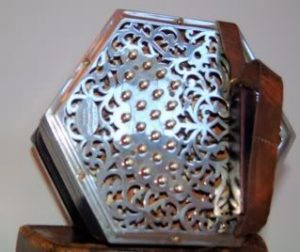
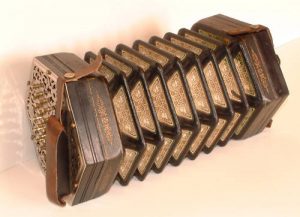
THE LATER YEARS, AFTER 1930
In his late 70s, Thomas Jeffries still occasionally harkened back to the Praed Street days. Although a sales receipt that he wrote on 4 September 1959 (see Fig. 53) shows “Jeffries Brothers, 5 Craven Park, Harlesden, NW10,” as does a letter dated 14 August 1961, which dispatches a concertina “keyboard” to a Mr. Floyd (probably Jim Floyd of Bristol, an active contributor to the ICA Newsletter at the time), another letter from the same period (dated July 30th, without year) prefaces the Craven Park address with “Late of 23 Praed St., Paddington W., ” while “Late of Praed St.” appears again at the end of the letter. Unfortunately, Thomas did not state “how late” of Praed Street. (All three documents are at the Horniman Museum.)
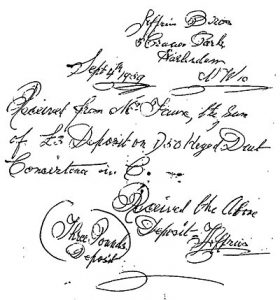
For a time, Thomas Jeffries supposedly built a few concertinas, upon which Tommy Williams commented as follows: “Then, of course, there was four sons – the last one [presumably Thomas] died some time back, and the ones he turned out was shocking.”28 A late as 1960, Thomas continued to trade as “Jeffries Bros.” from Harlesden, near Kilburn, and “Jeffries Bros.” is listed in an ICA Directory from 1958. Thomas Jeffries died in 1966.
George Jeffries did not work again after his injuries in World War I, except for a short period during World War II, when he worked in a factory contributing to the war effort.29 He lived near and kept in contact with brother Thomas.30 George died in 1965.
William Jeffries died in January 1954. He appears to have enjoyed a relatively luxurious life until the late 1930s. In the 1920s, he had a telephone, a status symbol at the time. In 1934, two years after the death of his wife Elizabeth Jesse, William Jeffries was on holiday in Morocco with his son Maurice (a surveyor in the civil service) and daughter-in-law Rhoda (born Rhoda McCarthy, 1903-1939). William Jeffries fell on hard times in the later 1930s.31 In 1914, his older son, William Earl Jeffries, emigrated to Australia, where he joined the Australian Imperial Force. In 1917, he returned to England, then went to the war in France. He returned to Australia in 1919, married, and died in Queensland in 1959.
Appendix 1: Stamping, Etching, and Handwriting in Jeffries Concertinas
Appendix 2: Handwritten Key Diagrams and Chord Charts from Jeffries Tutors
- We wish to thank Geoffrey Crabb, Suzanne Charles, Roger Digby, Colin Dipper, Pamela Forsey, Andrew Norman, Sheila Peckett, Pearl Pierce, Sandra Lazo, and Neil Wayne for comments and/or materials. We also thank Margaret Birley, the library staff, and those who are responsible for the concertina collection at the Horniman Museum. We wish to recognize the late Paul Davies, an Anglo player, concertina enthusiast, and dealer, who showed a relatively early interest in the Jeffries history, and who first managed to contact a Jeffries descendent. We have tried to provide credits for photographs obtained from outside sources, and we will welcome fuller information for credits.
- Many nineteenth-century makers learned about concertina construction through their associations with Wheatstone & Co. Before establishing their own shops, Rock and Edward Chidley, John Crabb, John Nickolds (and sons Thomas Nickolds and Frederick Charles Nickolds), William Dove, and Joseph Scates worked at Wheatstone & Co. Louis Lachenal began by making tools, concertina components, and entire concertinas for that firm. George Jones was apprenticed to Jabez Austin, who supplied components to Wheatstone & Co. See Neil Wayne, Concertina Book: Final Edit (unpublished typescript, 1986), 46-71; “Recollections of the English Concertina, from 1844, by George Jones, born February 29th 1832, Part I,” Concertina Magazine, 13 (Winter 1985): 4–5; Part II: 14 (Spring 1986): 4–7; Frank Butler, “Concertinas in the Commercial Road: The Story of George Jones,” Concertina & Squeezebox 20 (Summer 1989): 5–14; and Stephen Chambers, “Some Notes on Lachenal Concertina Production and Serial Numbers,” Papers of the International Concertina Association (PICA). 1 (2004), 3-23.
- John Hill Maccann, The Concertinist’s Guide: The Most Simple Modern Methods, How to Play Correctly, With or Without a Master (London: Howard & Co., 1888), 10.
- Information is unavailable about Charles Jeffries’ daughters and daughter-in-laws having engaged in concertina work, either before or after 1900. Presumably, they would have spent time in the Jeffries sales area and/or workshop, given that each of them resided in or near 23 Praed Street for some time.
- Robert William Carr (formerly a sculptor and artist in oils) was listed in the 1901 British census as “Musical Instrument Maker,” working for his own account at his home in London. The circumstantial evidence of an association with the Jeffries shop is based on similarities between Jeffries concertinas and those stamped “R. Carr.” A full-size Carr concertina and an 8-key miniature that appears to be a Carr instrument are in the Horniman Museum Collection, London. For a 48-key concertina by R. Carr, sold on Ebay in September 2004, the seller provided the following information: “This very rare instrument was made by R. Carr, an outworker for Jefferies [sic]. It is one of 4 [one other like this one] and 2 others similar) discovered when Carrs workshop effect’s [sic] were sold after his death. Most of the parts are identical to Jefferies [sic]. In November 2005, “Sagger” posted the following message at www.concertina.net: “I am a g. [great] grandson of Robert William Carr, Concertina Maker….my grandfather [was] Edward Charles Carr b. 1901…Robert had three other sons Robert, Frederick and Albert and a daughter May.” The posting did not mention any business relationship between Carr and the Jeffries firm.
- C. Streamer seems to have worked in the Jeffries shop, as well as working on his own account. In September 2006, Ian Streamer posted the following message at www.concertina.net: “My grandfather, to my knowledge, worked for Jeffries at some time and I believe that he made others on the side. In fact, I have one in my possession which does not bear the “Jeffries” name but just “C. Streamer maker.”
- At one time, we thought that S. Croggon might have worked for Jeffries, based on the appearance of a concertina stamped “S. Croggon” on one end, and “C. Jeffries, Maker” on the other. However, S. Croggon was later identified as a musician who owned the instrument with the personalized stamp. In August 2006, Peter Croggon posted the following message at www.concertina.net: “S. Croggon was my grandfather Samuel Croggon born in Soho in 1878. He died in 1937….The family had musical talents of a certain order….Family tradition says they had a band…and this is confirmed by a remote (from me) branch of the family.”
- The “Met” and all the buildings in that area were demolished in the mid-1960s during road improvements.
- Throughout this article, the air valve is excluded in the references to number of keys.
- Four generations of the Crabb family have been concertina makers. John James Crabb (1826-1903), a cabinet maker, went to work for Wheatstone & Co. in the late 1830s. In 1848, he teamed with John Nickolds and his two sons to form Nickolds, Crabb & Co. The firm was dissolved in 1860, and John Crabb worked at the Lachenal firm until 1868, when he established J. Crabb, English and Anglo German Concertina Manufacturer, later renamed J. Crabb & Sons. (In John Crabb’s view, the commencement of independent work overlapped with his Lachenal tenure, as indicated by stamps inside Crabb concertinas, showing “Crabb Est. 1860, 17 years foreman to L. Lachenal and Wheatstone.”) John’s brother, Charles Crabb (1833-1884), was also a concertina builder who also worked for the Lachenal firm, becoming one of the Lachenal & Co. owners from 1873 to 1883. After John Crabb’s death in 1903, the business was run by son Henry Crabb [senior], who subsequently changed the name to H. Crabb & Son. In 1930, Henry [senior] was succeeded by son Henry Joseph (“Harry”) Crabb, who ran the business until 1976. Harry’s son, Henry Neville, later joined by brother Geoffrey, operated the firm until it closed in the early 1990s after Neville’s death. Geoffrey Crabb recently restarted the building of Crabb concertinas, albeit in limited quantity.
- Information was provided by the curator of the St. Mary’s Hospital Museum. All Paddington buildings of the era are gone, and the sites have been totally redeveloped.
- Geoffrey Crabb provided us with information about the company’s activities related to Charles Jeffries. On the Crabb company, also see Roger Digby, “H. Crabb and Son, Concertina Maker,” at www.concertina.net; Frank E. Butler, The Concertina: A Handbook and Tutor for Beginners on the English Concertina (New York: Oak Publications, 1976), 3-4; Richard Carlin, English Concertina (New York: Oak Publications, 1977); and Neil Wayne, Concertina Book: Final Edit, 68-71.
- For example, according to Shay Fogarty (see General Discussion Forum at www.concertina.net), “the very earliest Jeffries are very similar to Crabb models made in the 1860s and 1870s. The way to see this is to check the siting [i.e., location] of the levers on the left side for the C drone and the G#/Bflat [;] they don’t cross but the G# lever is a short stumpy one and it’s difficult to replace the pad and get enough spring pressure on it.” For photos and analysis of a 31-key Crabb Anglo concertina of the later period (H. Crabb and Son), see Mark W. Stayton, “Inside a Crabb.”
- The 31 Aldermanbury address is listed for “Ilkee and Horne, CONC MAKER” from 1868 to 1878, and as “Ihlee and Sankey, in the dealers section (page 10) of John Hill Maccann’s The Concertinist’s Guide, 1888. Ball, Beavon, and Co. closed down around 1920. The Post Office London Directory of 1921 lists Ball, Beavon & Co. with a note indicating the company had been incorporated into Faudels Ltd of Newgate. A photo of a Salvation Army Anglo concertina band from the early 1920s—described at www.concertina.net—has an inscription that proclaims “a new set of instruments supplied by BB.”
- Tommy Williams Interview, Part 2, Concertina Newsletter, 5 (May 1972), 6.
- Tommy Williams, “Subscribers’ Letters,” Concertina Newsletter, 5 (May 1972), 14.
- Could the “hot plate” have been a panframe stove left over from the brushmaking days? The similarities were noted by the well-known concertina maker, Colin Dipper, of C & R Dipper & Son. A centerpiece of the pan shop was the panframe—a table around which four brushmakers (‘panhands”) stood. A charcoal stove stood in the center of the table and was used to heat the pitch—hot but not boiling—that adhered the bristles to the brushes.
- The signatures on both sales receipts from 1899 appear to belong to Charles Jeffries, given that the handwriting differs from signatures known to belong to Charles Jeffries jnr.
- Charles Jeffries jnr claimed to be the inventor of the Jeffries duet concertina. In 2007, one of the authors of this article represented Sheila Peckett (grand-daughter of Charles Jeffries jnr) in the purchase of a Jeffries duet inscribed “C. Jeffries, Maker & Inventor, 12 Aldershot Rd NW 6,” in the right-side oval. The reference to “Inventor” in the inscription was possibly meant to emphasize Jeffries’ claim of originality.
- On the smaller instruments, see Randall C. Merris, “Miniature and Semi-Miniature Concertinas,” Papers of the International Concertina Association, 9 (2012), 8-39; available online at www.concertina.org. Miniature concertinas are defined therein as those measuring 3 ¾ inches (95.25 mm) or less across their ends.
- The story behind Kimber’s Jeffries concertina is found in the booklet accompanying the CD, Absolute Classic: The Music of William Kimber (English Folk Dance and Song Society, 1999), 15-16: “The year 1901 was the turning point in the whole affair, with Bill Kimber providing regular dance demonstrations in [Cecil] Sharp’s lectures. The first occasion was on Thursday March 4 at the Steinway Hall, London …. It is certain that William Kimber played his [old] concertina on this occasion, because the press reported that the instrument broke, and an appeal to the audience raised £7 in subscriptions to buy a new one, which was presented several weeks later. The concertina, which William Kimber used for the rest of his life and which can be heard on this CD, was inscribed, ‘From the audience of Steinway Hall, March 4th 1909’.” The photo originally appeared on the cover of The Art of William Kimber, Topic Records, 12T249 (1974).
- In April 1909, Thomas Jeffries wed Victoria Helen Wade. The marriage record shows that her father, Henry Wade, was a “Licensed Victualler.” Thus, Thomas followed two career paths—the concertina trade of his father and the wine and spirit line of his father-in-law. Thomas and/or Henry Wade probably brought George Jeffries into the wine and spirit purveyance. The 1911 census records show that the wives of Thomas and George Jeffries—Victoria and May—assisted with the wine-spirit side of the business.
- The value conversion to 2002 equivalents is based on an historical index of average wages. See Randall C. Merris and Robert Gaskins, “Calculate Modern Values of Historic Concertina Prices.”
- According to Peter Hyde, “Letters,” Concertina & Squeezebox, 2/4 (Autumn 1984), 22, the same tool for bellows leather work was used on two of his Jeffries concertinas—a 23 Praed St. instrument and a 12 Aldershot Road instrument. The bellows on the second instrument may have been made by using Praed Street tools at the Aldershot Road location. However, Charles Jeffries jnr may have acquired the bellows from Praed Street inventory or in the secondary market.
- The original manuscript probably was destroyed in a fire that consumed the archives of Concertina & Squeezebox. The key diagram was introduced as follows: “The fingering chart was hand-made in England during the early 1940s in a little home-made tutor with extensive scales and chord charts, sent to us by Bertram Levy ….”; Concertina & Squeezebox, 14-15 (1987), 71.
- The 1939 National Identity Register, taken on 29 September 1939, was similar to a census, which was not undertaken in 1941. The 1939 Register was used for production of population statistics, identification cards, ration cards, conscription administration, monitoring and control of military mobilization, and mass evacuation.
- “NW 6” rather than just “NW” in the Kilburn address indicates the stamping occurred in or after 1917, when the postal designation was changed.
- “Tommy Williams Interview, Part 2,” 7.
- In the 1939 Register, George Jeffries, residing at 5A Craven Park, Willesden, is listed as be a “Porter Heavy Worker.”
- Thomas also contributed to the war effort. In the 1939 Register, Thomas Jeffries is listed as residing at 5 Craven Park and employed as an “Aircraft Work Fitter.”
- In the 1939 Register, William Jeffries is recorded as residing at 12 Langdon Drive, Wembley. Under the heading “Occupation” he is listed (in black-ink) as a “Ruined Man,” with the designation “Concertina Maker” subsequently added (in red-ink).
